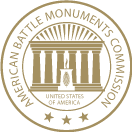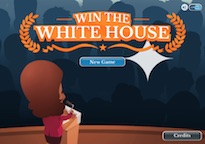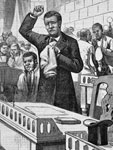Ohio Council for the Social Studies Annual Conference
The theme for this conference will be "Ohio Schools in a Global Setting."
The theme for this conference will be "Ohio Schools in a Global Setting."
From the National Council for the Social Studies Ning website:
"Learn about C-Span Classroom's outstanding free resources for social studies educators."
Note: To participate in this conference, you should be registered with the National Council for the Social Studies' Ning network.
From the History Channel website:
"Educators and students nationwide can tune-in and view this LIVE webcast online at www.veterans.com. The webcast will be broadcast live from the Library of Congress in Washington, D.C.
A panel of scholars and veterans will answer questions from students via video, email, and a live audience. The teach-in will focus on the histories and stories of World War II veterans, and will provide information on how communities nationwide can contribute to the Library of Congress' Veterans History Project. This event is part of the Take A Veteran to School Day initiative. For additional information, teacher resources, and tips for conducting oral histories with veterans, visit the Teacher Resources section at www.veterans.com. Stay tuned for more information about this event!"
From a National Museum of the American Indian email:
"Four hundred years ago, in 1609, Henry Hudson made his first voyage on the river that came to bear his name. To mark this historic event, Pace University commissioned Joseph Bruchac, a writer and educator of Abenaki descent, to create a play based on crew member Robert Juet's journal of the famous expedition. The play tells of the coming together of the European and Indian culture, in all of its complexities, and of the Indians' efforts to preserve and protect the river and their way of life.
Educators are invited to see a special presentation of the original play by noted author Joseph Bruchac (Abenaki) entitled The River of Tides. There will be a Q & A with Mr. Bruchac following the performance. Educators who pre-register will receive a companion curriculum."
For more on the National Museum of the American Indian, refer to NHEC's Museums and Historic Sites entry. Please note that this event takes place at the museum's New York City location.
From the Constitutional Rights Foundation Chicago website:
"CRFC's annual conference features over 20 teacher workshops on legal and political issues, interactive teaching methods, and innovative materials for the classroom. Participants can attend dynamic workshops featuring nationally recognized presenters, exchange ideas with colleagues from throughout the state, and take back free resource materials."

This American Battle Monuments Commission (ABMC) Burials and Memorializations database features over 224,000 records of individuals buried or memorialized in ABMC cemeteries and memorials worldwide. Covering 24 cemeteries in 10 foreign countries and 3 additional memorials in the U.S., this database provides online access to burial information of those killed in action primarily during World War I, World War II, the Korean War, and the Vietnam War.
Additional individuals include veterans, active duty military, and civilians. The database also provides information on individuals in the Corozal American Cemetery (Panama) and the Mexico City National Cemetery (Mexico), including civilians and veterans of the Spanish-American War and the Civil War.
The database interface allows students to search by name, war or conflict, service or serial number, branch of service, unit, service entry location, cemetery/memorial, date of death, and keyword. Users can also search for service members who are missing in action and Medal of Honor recipients who are buried or memorialized by ABMC.
This organization of the material allows the user to explore a wealth of information. Students can research the geographic distribution of burials or explore representation among military branches in individual cemeteries. The ABMC database allows users to focus on who is buried and memorialized and to explore the experiences of individual soldiers as well as patterns and commonalities.
Students, for example, could begin to explore the number of women who served as nurses during World War I and the Influenza epidemic of 1918, or the experiences of the 100th Infantry Battalion of the U.S. Army during World War II. Or they could chose to search for an individual from their home state or community and use the database’s information as a starting point to research the life of this individual. They can download search results and print, email, or share individual records.
This valuable research and teaching resource is accompanied by a robust “Education Resources” section featuring interactive timelines and campaign narratives, cemetery or memorial-specific mobile apps, publications, videos, lesson plans, and curriculum ideas. The “Flying Yanks: American Airmen in WWI” interactive, for example, provides historical background for students exploring the air war in WWI, a timeline and map with primary sources, as well as individual stories of airmen.
Students can use the database in conjunction with the learning materials to enrich their understanding of U.S. military history, memorialization, public history, and numerous other historical topics.

Win the White House is an online game that allows students to simulate a presidential campaign of their own. This includes debating, completing primaries, choosing a vice president, fundraising, making appearances, and more.
Visitors can register to play Win the White House or play without registering (both options are free). However, if the player is not registered, they cannot continue a campaign later. Win the White House works on both Macs and PCs.
To start, the player chooses a candidate, slogan, political party, and issues that they focus on, such as environment, health care, and voting laws. For older students, topics such as gun control and gay marriage are included. (Throughout the game, they will have to periodically answer questions regarding their platform or the platform that their opposition supports.) They then begin their political campaign. For support, as well as examples of use and teaching plans for the game, check out Win the White House: A Game Guide for Teachers.
During the political campaign, students will painlessly review the details of running a campaign, including how the electoral college works and how those votes are weighed, as well as how important political marketing is.
Playing the game can point out to students how many factors contribute to the progress and success of a presidential campaign. As students play, make sure they notice and use the four blue buttons at the top of the play screen map to view the states through different filters as their campaigns progress. With these buttons, they can remind themselves how many electoral votes each state has, see how the popular vote is going, keep track of states' momentum (are states leaning red or blue?), and check how much money each state still has available to fund campaigns.
Although Win the White House is a learning tool, it is also a game, adding motivation to learn and presenting students with many choices. Note that the game provides an assessment of how well the students achieved their objectives at the end, which can help teachers measure student comprehension. Win the White House can help teachers see how well students understand both the political process and the media’s potential to influence the outcome of an election.
Looking for more high-quality games for use in the history or civics classroom? iCivics, creator of Win the White House, features more than 20 online games on topics ranging from municipal planning to immigration to the Bill of Rights. Check out our Tech for Teachers on Do I Have a Right? for our take on one of iCivics' more addictive games.
Not certain how best to use games for teaching? High school teacher Jeremiah McCall shares his tips for getting the most out of games in his six-part blog series.

Textbooks often present a quick, uncomplicated overview of Reconstruction—a vast oversimplification of a time of social upheaval, tension, and violence. After Slavery: Race, Labor and Politics in the Post-Emancipation Carolinas, a joint project of Queen's University Belfast, the University of Memphis, and the University of London, provides primary sources that take a closer look at the time period.
Focusing on the themes of labor, race, and citizenship, After Slavery presents sources from North and South Carolina as examples of trends nationwide. A 2,500-word Introduction explores Reconstruction and the rationale for choosing the Carolinas as the project's focus. About the Project explains the structure and rationale behind the website's learning units.
The Learning Units form the heart of the site. Ten units cover topics including emancipation, mobilization, land and labor, black soldiers, conservative reactions, justice, gender, poverty and white supremacy, coercion and resistance, and the Republican Party. Each unit includes a 400-word introduction and six or more primary documents with three to eight discussion questions each. Units can be viewed online or downloaded as PDFs. An introductory essay explains the mission behind creation of the units, and Recommended Reading lists more than 80 books, 50 articles, and 15 primary sources.
As of December 7, 2012, other materials on the site are still content-light. Interactive Maps uses Google Maps to pinpoint only two events—the Hamburg Massacre and the Cainhoy Riot—with five to seven subevents included in each, as well as five-item lists of related sources.
Interactive Timelines includes three timelines with one-sentence descriptions on each item. Timelines look at general Reconstruction history as well as Reconstruction in North and South Carolina. Teacher Resources currently features links to more than 30 digital collections and exhibits, research tools, military records, audiovisual resources, and more. The section notes that lesson plans will be added in the future.
A valuable resource for teachers looking to complicate the textbook narrative on Reconstruction, and for teachers covering North or South Carolina history.